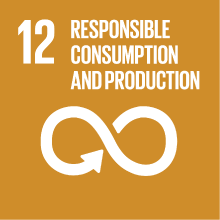BIOORGANIC CHEMISTRY - MOD. 2
- Academic year
- 2022/2023 Syllabus of previous years
- Official course title
- BIOORGANIC CHEMISTRY - MOD. 2
- Course code
- CM0591 (AF:374634 AR:212332)
- Teaching language
- English
- Modality
- On campus classes
- ECTS credits
- 6 out of 12 of BIOORGANIC CHEMISTRY
- Degree level
- Master's Degree Programme (DM270)
- Academic Discipline
- CHIM/06
- Period
- 1st Semester
- Course year
- 1
- Where
- VENEZIA
- Moodle
- Go to Moodle page
Contribution of the course to the overall degree programme goals
Expected learning outcomes
Students will have to acquire:
a) mastery of basic knowledge relating to organic chemistry, correlating them to the main reactive pathways and the different types of supramolecular interactions underlying the reactions that occur in living systems.
b) ability to recognize the main classes of biological and biomimetic reactions and the main chemical interactions (bonding and non-binding) that regulate them;
c) understand the principles of organic reactivity that underlie the functioning of biological systems and the development of biomimetic systems.
Ability to apply knowledge and understanding:
Students will have to be able to apply the acquired knowledge in an appropriate, relevant and flexible way in order to elaborate, adopting appropriate chemical symbols, the biosynthetic and biomimetic reactions studied in depth in the course. In the laboratory part, students will apply theoretical knowledge to simple reactions of biological interest by appropriately processing the data obtained experimentally with the aim of studying the reaction trend, developing methods of quantification and purification of compounds of biological origin, determining the course regio and stereochemical of enzymatic reactions and perform reactions of biochemical relevance with biomimetic synthesis catalysts.
Autonomy of judgment:
Students will have to demonstrate critical reasoning skills and, through the knowledge acquired during the course, will have to identify, in a schematic and appropriate way, the correlations between the reactivity of organic compounds and biological systems, applying them to practical laboratory problems and to the development of biomimetic systems .
Communication skills:
a) Knowing how to properly use the terminology and symbology developed during the course;
b) Knowing how to interact actively with the teacher and classmates, so that communication takes place in a constructive and formally correct manner;
c) Knowing how to constructively communicate with teachers, tutors and laboratory companions during laboratory experiences while always maintaining a high level of attention and chemical understanding on the experimental work that is being carried out, using the correct terminology and nomenclature, in a way that is as concise but exhaustive as possible, with sufficient display safety.
5. Learning skills:
a) Knowing how to take notes rigorously, highlighting the concepts learned according to their importance;
b) Knowing how to integrate the teaching material provided by the teacher with his own clear notes;
c) Knowing how to critically discuss the concepts of the course in an appropriate, relevant and effective way, both in written and oral form;
d) Being able to record, during the laboratory experiences, the experimental results and the macroscopic and chromatic variations observed and to relate them to the information acquired during the theoretical part of the course and the introductory laboratory lessons;
d) Knowing how to draw up group laboratory reports of a few pages in length that present the objective of the experience, the experimental data and the discussion of these in a clear, succinct and exhaustive manner.
Pre-requirements
Contents
-Catalytic perfection of enzymes. Classification of enzymes. Stereochemistry in enzymatic reactions.
- Effects of proximity, orientation and distortion. Intramolecular catalysis. Effective molarity. Distortion of the substrate. Specificity, selectivity and recognition, substrate selectivity.
-Mechanism of action of co-enzymes: NAD and NADP, FAD, Biotin, thiamine pyrophosphate, folic acid, ascorbic acid, pyridoxal phosphate, chemical role of vitamins.
- Enzymatic reactions with group transfer: hydrolysis (peptidase, lipase and esterase), phosphorylation (hydrolysis of phosphoric esters. Phosphatase and phosphodiesterase), transamination.
- Redox reactions with NAD-dependent enzymes (alcohol dehydrogenase) and FAD-dependent (monooxygenase and glutathione reductase) and metal-dependent enzymes (cytochromes P450).
- Reactions involving C-C bond formation and scission, via carbanion (class 1 and 2 aldolase), carbocation (squalene oxide cyclase), radical (methylmalonyl CoA mutase). Examples of pericyclic reactions, nucleophilic substitutions, 1,2-eliminations, decarboxylations and carboxylations.
- Bio-catalyzed radical reactions.
-Enzyme kinetic solutions. Dynamic kinetic resolutions.
-Examples of the application of enzymes such as hydrolases in the production of enantiopure amino acids (natural and non-natural) and compounds for the pharmaceutical industry. Use of dehydrogenases in bio-catalysis and problems related to the regeneration of the cofactor.
- Catalytic antibodies.
Lab. activities Mod. 2 (18h, 3 days):
-Applications of supramolecular systems in the recognition of biologically relevant molecules;
-Enzymatic catalysis for the kinetic resoution and/or for aldol condensation reactions;
-Model experience of enzyme mimesis in the hydrolysis of RNA analogues.
Attendance of the lab activities is mandatory.
Referral texts
Ulf Diederichsen (Editor), Thisbe K. Lindhorst (Editor), B. Westermann (Editor), Ludger A. Wessjohann (Editor)
ISBN: 978-3-527-29665-1
Richard B. Smith “Biochemistry. An Organic Chemistry Approach” CRC Press, 2020, ISBN: 978-0-8153-6713-0.
Assessment methods
The overall evaluation of this course consists of the weighted average of the mark of the written and oral test (70%) and the mark of the laboratory reports (30%).
Type of exam
Teaching methods
Laboratory experiences: The course includes a series of practical laboratory experiences (5-6 depending on the speed of execution of the groups for a total duration in the two teaching modules of 8 days of approximately 5 hours each) which will be held at the Organic Chemistry teaching laboratory, Beta Building, 1 floor. These laboratory days will be preceded by a series of lectures (12 hours, divided into two academic hours) introductory regarding the description of the experiences integrated with quick insights into the main analysis techniques used.
At the beginning of the first day of the laboratory, i) the main individual and collective safety rules to be kept in the teaching laboratory and ii) the importance of the use of personal protective equipment and the correct use of chemical products will be reiterated.
The teaching material will be made available on the University Moodle platform and includes PDF copies of the slides projected during the lessons, a copy of the experimental procedures to be followed for the laboratory experiences, and the files of the experimental data collected during the laboratory experiences.
Further information
Accommodations and Support Services for students with disabilities or with specific learning disabilities:
Ca 'Foscari applies Italian law (Law 17/1999; Law 170/2010) for support and accommodation services available to students with disabilities or with specific learning disabilities. In case of motor, visual, hearing or other disabilities (Law 17/1999) or a specific learning disorder (Law 170/2010) and you need support (classroom assistance, technological aids for carrying out exams or individualized exams, material in accessible format, recovery of notes, specialized tutoring to support the study, interpreters or other), contact the Disability and SLD office. disabilita@unive.it.
2030 Agenda for Sustainable Development Goals
This subject deals with topics related to the macro-area "Circular economy, innovation, work" and contributes to the achievement of one or more goals of U. N. Agenda for Sustainable Development


